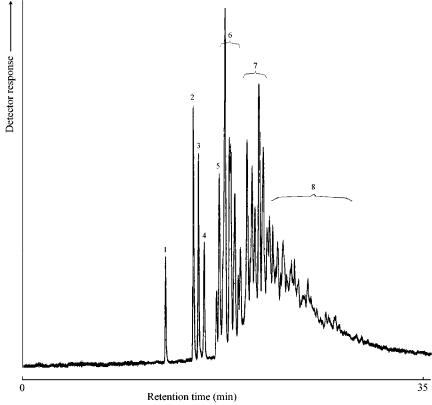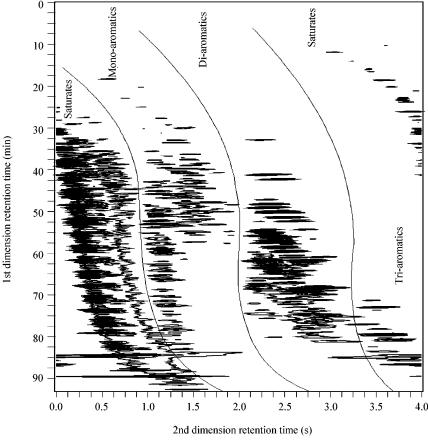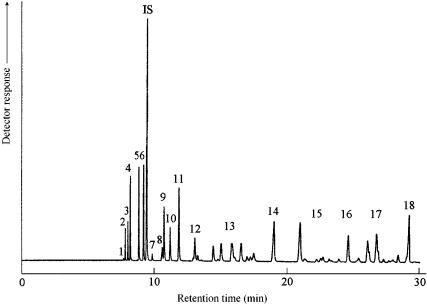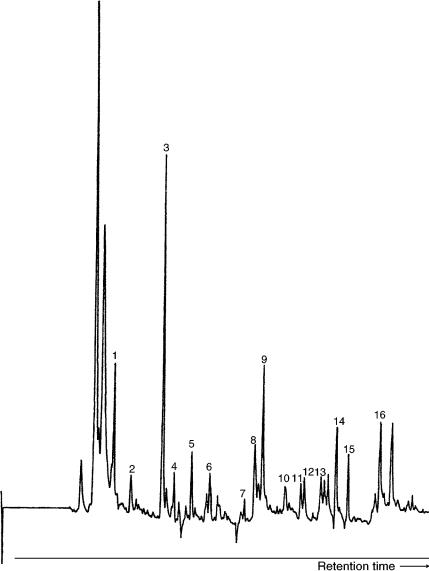
Multidimensional Chromatography
.pdf
400 |
Multidimensional Chromatography |
Figure 14.21 GC chromatogram of the dibenzothiophenes fraction of a heavy gas-oil sample. Peak identification is as follows: 1, dibenzothiophene; 2, 4-methyldibenzothiophene; 3, 2- methyldibenzothiophene; 4, 3-methyldibenzothiophene; 5, 4,6-dibenzothiophene; 6, other C2-dibenzothiophenes, 7, C3-dibenzothiophenes; 8, C4- and higher dibenzothiophenes.
Phillips and Xu have presented two-dimensional (2D) chromatograms of kerosines, separated with different stationary phase combinations, in many thousands of components (37). Frysinger et al. have separate benzene – toluene – ethyl benzene – xylenes (BTEX) and total aromatics in gasolines by using GC GC (38). These authors also analysed marine diesel fuel with GC GC, connected to a quadrupole mass spectrometer for identification purposes, although the scan speed of the spectrometer was not quite suited for the fast second-dimension peaks (39). GC GC was used as an excellent tool for identifing oil spill sources by Gaines et al. (40). Synovec and co-workers used the GC GC separation of mixtures of toluene, ethylbenzene, m- and o-xylenes and propylbenzene in white gas to investigate the use of generalized rank annihilation methods (GRAMs) for quantitation purposes (41), while Kinghorn and Marriott used the separation of kerosine to demonstrate the cryogenic modulator (42). Although quantitation of

Multidimensional Chromatographic Applications in the Oil Industry |
401 |
Figure 14.22 Contour plot of the GC GC separation of a heavy gas oil sample; the thin lines indicate the borders between the groups.
the massive data matrix is possible and provides excellent results (36), no software, which is compatible with all of the various GC GC analyses, is yet available.
An overview of the state-of-the-art of GC GC is given in (43).
14.5RESIDUE-CONTAINING PRODUCTS
These products comprise whole crude oils, as well as bottom fractions of distilling units and (partly) converted materials. The common property of these products is the fact that they contain high-boiling material which is not amenable to gas chromatographic analysis.
402 |
Multidimensional Chromatography |
Nevertheless, a number of gas chromatographic applications exist, epecially those for the determination of crude oil indicators. Such indicators are used as geochemical parameters for the thermal history of the crude as well as to indicate the possible relationship between crudes from different wells. These indicators comprise a number of isomeric aromatic species, such as the individual alkylnaphthalenes (44, 45), the individual C10-mono-aromatics or the individual C9-mono-aromatics. The ratio between these isomers gives a definite indication of the crude oil. In general, these systems use a Deans switching unit to make a heart-cut, which then is focused, reinjected and separated on a second column with a different polarity.
14.5.1 A DETAILED HYDROCARBON ANALYTICAL SYSTEM COUPLED TO A SIMULATED DISTILLATION PROCESS
The main characteristic of a crude oil for processing is its boiling range, which is generally determined by (single-column) gas chromatography, and is designated as ‘simulated distillation’. Because this analysis is performed with a ‘high-temperature’ (short, thin film, highly temperature stable, etc.) column, the lower part of the boiling range is not too well separated and defined. In order to determine the economic value, as well as to predict and control the optimum (crude) distillation cut points, this low-boiling part can be determined with a valve switched pre-column. The ‘high temperature’ column is fitted in the GC oven, which is temperature programmed up to temperatures of around 400 °C. In a separate valve oven, a second, high resolution capillary column with a valve is accommodated. This column will separate isothermally the light end (in which an internal standard, 3,3-dimethyl-1-butene, is included) of the sample, e.g. up to C9, as shown in Figure 14.23. The remaining part is back-flushed to vent. A separate injection is performed on to the ‘high-tempera- ture’ column for the simulated distillation. A software program then enables the incorporation of the two data sets into a final report.
14.5.2 AN SEC – LC – GC SYSTEM FOR THE ANALYSIS OF ‘LOW BOILING’ MATERIALS IN RESIDUAL PRODUCTS
A more complicated, but flexible, system has been reported by Blomberg et al. (46). Here, size exclusion chromatography (SEC), normal phase LC (NPLC) and GC were coupled for the characterization of restricted (according to size) and selected (according to polarity) fractions of long residues. The seemingly incompatible separation modes, i.e. SEC and NPLC, are coupled by using an on-line solvent-evap- oration step.
Another interesting, but rather complex system, which couples flow injection analysis, LC and GC has been recently reported (47). This system allows the determination of the total amount of potentially carcinogenic polycyclic aromatic compounds (PACs) in bitumen and bitumen fumes. This system could also be used for the analysis of specific PACs in other residual products.

Multidimensional Chromatographic Applications in the Oil Industry |
403 |
Figure 14.23 GC Light-end separation of a sample of crude oil. Peak identification is as fol-
lows: 1, C3; 2, i-C4; 3, n-C4; 5, 2-methyl-C4; 6, n-C5; 7, 2,2-dimethyl-C4; 8, cyclo-C5 2,3- dimethyl-C4; 9, 2-methyl-C5; 10, 3-methyl-C5; 11, n-C6; 12, methyl-cyclo-C5; 13, C7s; 14,
n-C7; 15, C8s; 16, n-C8; 17, C9s; 18, n-C9; IS, internal standard (3,3-dimethyl-1-C4–).
ACKNOWLEDGEMENTS
The author would like to thank Jan Blomberg of the Shell Research and Technology Center, Amsterdam and Dolf Grutterink of Analytical Controls, Rotterdam for kindly supplying some of the chromatograms and schematic diagrams.
REFERENCES
1.S. W. Green, ‘The quantitative analysis of mixtures of chlorofluoromethanes in vapour phase chromatography’, in Vapour Phase Chromatography D. H. Desty (Ed.), Butterworths, London, pp. 388 (1957).
2.F. Harrison, P. Knight, R. P. Kelly and M. T. Heath, ‘The use of multiple columns and programmed column heating in the analysis of wide-boiling range halogenated hydrocarbon samples in gas chromatography’, in Gas Chromatography D. H. Desty (Ed.), Butterworths, London, pp. 216–247 (1958).
3.M. G. Bloch, ‘Determination of C1-through C7-hydrocarbons in a single run by a fourstage gas chromatograph’, in Proceeding of the 2nd International Symposium on Gas Chromatography, East Lansing, MI, USA H. J. Noebels (Ed.) Academic Press, New York pp. 133–162 (1961).
404 |
Multidimensional Chromatography |
4.American Society for Testing and Materials, Annual Book of ASTM Standards, Section 5, American Society for Testing and Materials, Philadelphia, PA, USA (1999).
5.The Institute of Petroleum, IP Standard Methods for Analysis and Testing of Petroleum and Related Products and British Standards, John Wiley & Sons, Chichester, UK (1999).
6.Universal Oil Products Process Division, Des Plaines, IL, USA.
7.Deutsches Institut für Normung Fachausschuss Mineralölund Brennstoffnormung, Hamburg, Germany.
8.Gas Processors Association (GPA) Standards, Tulsa, OK, USA.
9.R. S. Hutte, ‘The sulfur chemiluminescence detector’, J. Chromatogr. Libr. 56: 201 – 229 (1995).
10.D. R. Deans, ‘An improved technique for back-flushing gas chromatographic columns’, J. Chromatogr. 18: 477 – 481 (1965).
11. D. R. Deans, ‘A new technique for heart cutting in gas chromatography’,
J. Chromatogr. 1: 18 – 22 (1968).
12.H. Boer and P. van Arkel, ‘Automatic PNA (paraffins – naphthenes – aromatics), analyser for (heavy), “naphtha”’, Chromatographia 4: 300 – 308 (1971).
13.J. V. Brunnock, ‘Separation and distribution of normal paraffins from petroleum heavy distillates by molecular sieve adsorption and gas chromatography’, Anal. Chem. 38: 1648 – 1652 (1966).
14.H. Boer, P. van Arkel and W. J. Boersma, ‘An automatic paraffins – naphthenes – aromatics (PNA), analyzer for the under 200 °C fraction contained in a higher boiling product’,
Chromatographia 13: 500 – 512 (1980).
15.P. van Arkel, J. Beens, H. Spaans, D. Grutterink and R. Verbeek, ‘Automated PNA analysis of naphthas and other hydrocarbon samples’, J. Chromatogr. Sci. 25: 141 – 148 (1988).
16.J. J. Szakasits and R. E. Robinson, ‘Hydrocarbon type determination of naphthas and catalytically reformed products by automated multidimensional gas chromatography’, Anal. Chem. 63: 114 – 120 (1991).
17.M. G. Block, R. B. Callen and J. H. Stockinger, ‘The analysis of hydrocarbon products obtained from methanol conversion to gasoline using open tubular GC columns and selective olefin absorption’, J. Chromatogr. Sci. 15: 504 – 512 (1977).
18.F. P. DiSanzo, J. L. Lane and R. E. Yoder, ‘Application of state-of-the-art multidimensional high resolution gas chromatography for individual component analysis of gasoline range hydrocarbons’, J. Chromatogr. Sci. 26: 206 – 209 (1988).
19.F. P. DiSanzo and V. J. Giarrocco, ‘Analysis of pressurized gasoline-range liquid hydro-
carbon samples by capillary column and PIONA analyzer gas chromatography’,
J. Chromatogr. Sci. 26: 258 – 266 (1988).
20.T. J. Lechner-Fish and S. L. Ryder, ‘Analysis of simulated petroleum wellhead fluids using multidimensional gas chromatography’, Am. Lab. 29: 33X – 33EE (1997).
21.H. J. W. Henderickx and J. J. M. Ramaekers, ‘Analysis of a C 9 –C10 aromatic hydrocarbon pyrolysis distillate by multidimensional capillary GC and multidimensional capillary GC – MS’, J. High Resolut. Chromatogr. 17: 407 – 410 (1994).
22.S. T. Teng, A. D. Williams and K. Urdal, ‘Detailed hydrocarbon analysis of gasoline by GC – MS (SI-PIONA)’, J. High Resolut. Chromatogr. 17: 469 – 475 (1994).
23.J. A. Apffel and H. McNair, ‘Hydrocarbon group-type analysis by on-line multi-
dimensional chromatography. II. Liquid chromatography – gas chromatography’,
J. Chromatogr. 279: 139 – 144 (1983).
24.P. C. Hayes-Jr and S. D. Anderson, ‘Paraffins, olefins, naphthenes and aromatics analysis of selected hydrocarbon distillates using on-line column switching high-performance
Multidimensional Chromatographic Applications in the Oil Industry |
405 |
liquid chromatography with dielectric constant detection’, J. Chromatogr. 437: 365 – 377 (1988).
25.I. L. Davies, K. D. Bartle, P. T. Williams and G. E. Andrews, ‘On-line fractionation and identification of diesel fuel polycyclic aromatic compounds by two-dimensional microbore high-performance liquid-chromatography/capillary gas-chromatography’, Anal. Chem. 60: 204 – 209 (1988).
26.A. Trisciani and F. Munari, ‘Characterization of fuel samples by on-line LC – GC with automatic group-type separation of hydrocarbons’, J. High Resolut. Chromatogr. 17: 452 – 456 (1994).
27.F. Munari, A. Trisciani, G. Mapelli, S. Trestianu, K. Grob-Jr and J. M. Colin, ‘Analysis of petroleum fractions by on-line micro HPLC – HRGC coupling, involving increased efficiency in using retention gaps by partially concurrent solvent evaporation’, J. High Resolut. Chromatogr. 8: 601 – 606 (1985).
28.I. L. Davies, M. Raynor, P. T. Williams, G. E. Andrews and K. D. Bartle, ‘Application of an automated on-line microbore high-performance liquid chromatography/capillary gas chromatography to diesel exhaust particulates’, Anal. Chem. 59: 2579 – 2583 (1987).
29.I. L. Davies, K. D. Bartle, G. E. Andrews and G. T. Williams, ‘Automated chemical class characterization of kerosene and diesel fuels by on-line coupled microbore HPLC/capillary GC’, J. Chromatogr. Sci. 26: 125 – 130 (1988).
30.G. W. Kelly and K. D. Bartle, ‘The use of combined LC – GC for the analysis of fuel products: a review’, J. High Resolut. Chromatogr. 17: 390 – 397 (1994).
31.J. Beens and R. Tijssen, ‘An on-line coupled HPLC – HRGC system for the quantitative characterization of oil fractions in the middle distillate range’, J. Microcolumn Sep. 7: 345 – 354 (1995).
32.J. Beens and R. Tijssen, ‘The characterization and quantitation of sulfur-containing compounds in (heavy) middle distillates by LC – GC-FID-SCD’, J. High Resolut. Chromatogr. 20: 131 – 137 (1997).
33.Z. Liu and J. B. Phillips, ‘Comprehensive two-dimensional gas chromatography using an on-column thermal modulator interface’, J. Chromatogr. Sci. 29: 227 – 231 (1991).
34.C. J. Venkatramani and J. B. Phillips, ‘Comprehensive two-dimensional gas chromatography applied to the analysis of complex mixtures’, J. Microcolumn Sep. 5: 511 – 516 (1993).
35.J. Blomberg, P. J. Schoenmakers, J. Beens and R. Tijssen, ‘Comprehensive twodimensional gas chromatography (GC GC), and its applicability to the characterization of complex (petrochemical) mixtures’, J. High Resolut. Chromatogr. 20: 539 – 544 (1997).
36.J. Beens, H. Boelens, R. Tijssen and J. Blomberg, ‘Quantitative aspects of comprehensive two-dimensional gas chromatography (GC GC)’, J. High Resolut. Chromatogr. 21: 47 – 54 (1998).
37.J. B. Phillips and J. Xu, ‘Comprehensive multi-dimensional gas chromatography’, J. Chromatogr. 703: 327 – 334 (1995).
38.G. S. Frysinger, R. B. Gaines and E. B. Ledford-Jr, ‘Quantitative determination of BTEX and total aromatic compounds in gasoline by comprehensive two-dimensional gas chromatography (GC GC)’, J. High Resolut. Chromatogr. 22: 195 – 200 (1999).
39.G. S. Frysinger and R. B. Gaines, ‘Comprehensive two-dimensional gas chromatography with mass spectrometric detection (GC GC/MS), applied to the analysis of petroleum’,
J. High Resolut. Chromatogr. 22: 251 – 255 (1999).
40.R. B. Gaines, G. S. Frysinger, M. S. Hendrick-Smith and J. D. Stuart, ‘Oil spill source identification by comprehensive two-dimensional gas chromatography’, Environ. Sci. Technol. 33: 2106 – 2112 (1999).
406 |
Multidimensional Chromatography |
41.C. A. Bruckner, B. J. Prazen and R. E. Synovec, ‘Comprehensive two-dimensional highspeed gas chromatography with chemometric analysis’, Anal. Chem. 70: 2796 – 2804 (1998).
42.R. M. Kinghorn and P. J. Marriott, ‘Enhancement of signal-to-noise ratios in capillary gas chromatography by using a longitudinally modulated cryogenic system’, J. High Resolut. Chromatogr. 21: 620 – 631 (1998).
43.J. B. Phillips and J. Beens, ‘Comprehensive two-dimensional gas chromatography: a hyphenated method with strong coupling between the two dimensions’, J. Chromatogr. 856: 331 – 347 (1999).
44.R. G. Schaefer and J. Höltkemeier, ‘Direct analysis of alkylnaphthalenes in crude oils by two-dimensional capillary gas chromatography’, Chromatographia 26: 311 – 315 (1988).
45.R. G. Schäfer and J. Höltkemeier, ‘Direkte Analyse von Dimethylnaphtalinen in Erdölen mittels zweidimensionaler kapillar Gas-chromatographie’, Anal. Chim. Acta 260: 107 – 112 (1992).
46.J. Blomberg, E. P. C. Mes, P. J. Schoenmakers and J. J. B. van der Does, ‘Characterization of complex hydrocarbon mixtures using on-line coupling of size-exclusion chromatography and normal-phase liquid chromatography to high-resolution gas chromatography’,
J. High Resolut. Chromatogr. 20: 125 – 130 (1997).
47.J. Blomberg, P. C. de Groot, H. C. A. Brandt, J. J. B. van der Does and P. J. Schoenmakers, ‘Development of an on-line coupling of liquid – liquid extraction, normalphase liquid chromatography and high-resolution gas chromatography producing an analytical marker for the prediction of mutagenicity and carcinogenicity of bitumen and bitumen fumes’, J. Chromatogr. 849: 483 – 494 (1999).

Multidimensional Chromatography
Edited by Luigi Mondello, Alastair C. Lewis and Keith D. Bartle
Copyright © 2002 John Wiley & Sons Ltd
ISBNs: 0-471-98869-3 (Hardback); 0-470-84577-5 (Electronic)
15Multidimensional Chromatography: Forensic and Toxicological Applications
NICHOLAS H. SNOW
Seton Hall University, South Orange, NJ, USA
15.1 INTRODUCTION
In forensic science and toxicology, chemical analysis involves the detection and identification of compounds that are indicators of disease, poisons, and many types of illegal activities. Often, the analytes are found in difficult matrices such as tissues, urine, blood, serum, hair, arson debris, and shards of a variety of materials. Since there may also be many possible analytes for a given sample, extraction and chromatographic techniques are widely employed in forensic and toxicological analysis as a means for separating the analytes of interest from the complex matrix, and from each other, prior to identification. Often, identification by an orthogonal technique such as mass spectrometry is required. In classical chromatographic analysis, the complexity of the samples and matrices, combined with the need for positive identification and quantitative detection of the analytes, generally means that sample preparation methods must be extensive and laborious. Several authors have recently reviewed classical methods for forensic and toxicological analysis by using chromatography (1 – 3).
In order to reduce or eliminate off-line sample preparation, multidimensional chromatographic techniques have been employed in these difficult analyses. LC – GC has been employed in numerous applications that involve the analysis of poisonous compounds or metabolites from biological matrices such as fats and tissues, while GC – GC has been employed for complex samples, such as arson propellants and for samples in which special selectivity, such as chiral recognition, is required. Other techniques include on-line sample preparation methods, such as supercritical fluid extraction (SFE) – GC and LC – GC – GC. In many of these applications, the chromatographic method is coupled to mass spectrometry or another spectrometric detector for final confirmation of the analyte identity, as required by many courts of law.
In this present chapter, the applications of multidimensional chromatography to forensic and toxicological analysis are described in detail, being organized by technique. While multidimensional chromatography has not been as widely applied in
408 |
Multidimensional Chromatography |
forensic science as in environmental and food science, many of the methods and ideas presented in those areas could be readily applied to forensic problems. Little detail in instrumental set-ups is given here, as these are described elsewhere in this volume.
15.2LIQUID CHROMATOGRAPHY – GAS CHROMATOGRAPHY
Liquid chromatography (LC) has been used primarily as an on-line sample clean-up method prior to high resolution capillary GC analysis. Primarily, this has involved the retention of fats and other high-molecular-weight matrix components in the analysis of drugs or pesticides from a variety of matrices such as foods, tissues and fat. LC – gas chromatography (GC) has not been widely employed in forensic and toxicological analysis, although this technique shows promise for simplifying sample preparation, especially in cases where sample volume is limited.
Van der Hoff, and co-workers (4 – 6) have used on-line LC – GC to separate and determine organochlorine pesticides and polychlorinated biphenyls (PCBs) from a variety of fatty matrices, including cow’s and human milk, and liposuction biopts. In the most recent method, following treatment with sodium oxalate and extraction with hexane, these authors used a normal phase HPLC column, (typically, 50 mm 1 mm 3 m Hypersil 50, or 30 mm 2.1 mm 5 m Spherisorb) followed by direct transfer to capillary GC with electron-chapture detector (ECD) detection. They found detection limits of about 0.3 – 2 g/kg of fat for a variety of pesticides and PCB’s from milk. This paper provides an excellent example of how LC – GC could be employed for the analysis of many other compounds of toxicological interest from fatty matrices. Barcarolo (7) also provides an LC – GC method for pesticide residues from fat, using a reversed phase clean-up prior to high resolution capillary GC. A description of a home-built LC – GC system is provided, along with extensive experimental detail. An LC – GC – ECD chromatogram of a butter sample, which may be considered representative of other high-fat-content matrices is shown in Figure 15.1. Several pesticides are successfully extracted from the fat matrix and separated with a minimum of prior sample preparation. They also observed a limited lifetime for the C18 LC column of about 25 – 30 injections before washing was required.
Chappell et al. (8) used LC coupled to two-dimensional GC in the analysis of illegal growth hormones from corned beef. In order to re-focus the chromatographic bands between stages, cryogenic focusing was employed. Figure 15.2 shows the three stages of separation of stilbene hormones form corned beef. The HPLC separation is shown in stage 1, in which a small sample is heart-cut into the first GC column. During the first GC separation, another sample is heart-cut into the second GC column. The third chromatogram shows the complete separation of several hormones, with a total analysis time of about 40 min. Chappell and co-workers also show examples of the removal of matrix interferences by cryogenically focusing them between the two GC columns.

Forensic and Toxicological Applications |
409 |
Figure 15.1 Separation of pesticides from butter by using LC – GC-ECD. Peak identification is as follows: 1, HCB; 2, lindane; 5, aldrin; 7, o, p -DDE; 10, endrin; 11, o,p -DDT; 13, p,p -DDT: peaks 3, 4, 6, 8, 9, 12, 14, 15 and 16 were not identified. Adapted from Journal of High Resolution Chromatography, 13, R. Barcarolo, ‘Coupled LC – GC: a new method for the on-line analysis of organchlorine pesticide residues in fat’, pp. 465 – 469, 1990, with permission from Wiley-VCH.
